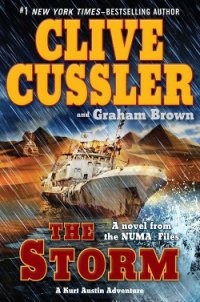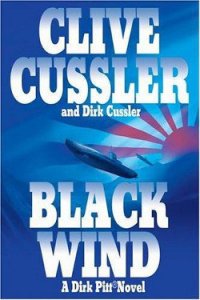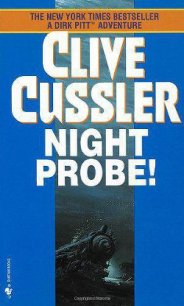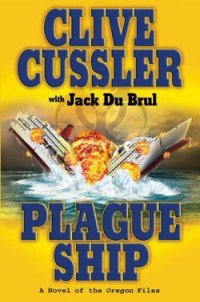Flood Tide - Cussler Clive (читать книги без txt) 📗
Once safely out to sea, Hanley, like the rest of the dedicated crew members, transformed himself into a different person by donning comfortably casual clothes better suited for a golf course. He wore sneakers and was dressed in white shorts and a maroon polo shirt. He held a cup of coffee in one hand. His skin was reddened with no trace of tan, the brown eyes alert, a bulbous nose and only a wisp of auburn hair splayed across his head.
“A lot of history on that old rock,” said Hanley. “I always come topside when we slip past her.”
“She's pretty quiet now,” replied Pitt. “My father died over there in 'forty-two when the big gun he was manning took a direct hit from a Japanese bomber.”
“A lot of good men died with him.”
“That they did.” Hanley looked into Pitt's eyes. "I'll be directing the descent into the water and retrieval of your submersible. Anything me or my engineers can help you with in regard to your equipment and electronics, you just holler.
There is something.
Name it."
“Could your crew do a quick repaint of the Sea Dog II? The NUMA turquoise trademark color is highly visible in shallow water from the surface.”
“What color would you like?” asked Hanley. “A medium green,” explained Pitt, “a shade that blends with the water in the harbor.”
“I'll get my boys on it first thing.” Hanley turned and leaned against the rail with his back, staring up at the wisp of smoke drifting from the ship's funnel. “Seems to me it might have been a whole lot simpler to use one of them underwater robotic vehicles.”
“Or an autonomous underwater vehicle,” said Pitt, smiling. “Neither would prove as efficient as a manned submersible for inspecting the bottom of a hull the size of the United States. The sub's manipulator arm may also prove useful. There are certain projects where human eyesight is advantageous over video cameras. This happens to be one of them.”
Hanley read the dial of an old pocket watch whose chain was hooked to a belt loop. “Time to program the engine and navigation systems. Now that we've reached open water, the chairman will want to triple our speed.”
“We must be doing close to nine or ten knots now,” said Pitt, his curiosity piqued.
“Strictly a performance,” Hanley said candidly. “Whenever the old Oregon is in sight of prying eyes around the harbor or other ships that pass at sea, we like to make her look as if her antique engines and screws are straining to make headway. Which is the way she should appear for an old tub. In truth, she's been modified with two screws turned by twin diesel turbine engines that can push her past forty knots.”
“But with a full load of cargo, your hull is riding low in the water and causing a heavy drag.”
Hanley tilted his head toward the cargo hatches and the wooden crates tied to the deck. “All empty. We ride low because we fill specially installed ballast tanks to give the appearance of a heavily laden ship. Once they're pumped out, she'll rise six feet and take off four times faster than when she was built.”
“A fox in disguise.”
“With the teeth to match. Ask Chairman Cabrillo to show you how we bite back if we're attacked.”
“I'll do that.”
“Good night, Mr. Pitt.”
“Good night, Mr. Hanley.”
Ten minutes later Pitt felt the ship come to life as the vibrations from the engines increased dramatically. The wake turned from a white spreading scar to a boiling cauldron. The stern sank by a good three feet, the bow raised in an equal proportion and creamed white. The water rushed along the hull as if swept away by a giant broom. The sea shimmered under an awning of stars that outlined a scattering of thunderclouds on the horizon. It was a postcard South China Sea evening with an orange-tinted sky to the west.
The Oregon approached the outer reaches of Hong Kong Harbor two days later, making landfall at sunset. She had made the crossing from Manila in remarkable time. Twice, upon meeting other freighters during daylight, Cabrillo gave the order for slow speed. Several of the crew always quickly dressed in their shabby coveralls, assembled on deck and peered across the gap between the passing ships, staring blankly at what Cabrillo called a show of dummies. In an unwritten tradition of the sea, the crews of overtaking or passing ships coming together at sea never showed any animation. Only their eyeballs moved and blinked. Passengers wave, but merchant seamen always act uneasy when looking at crewmen on another ship. Usually, they offer a stiff little wave from a hand draped over the rail before disappearing inside their ship. Once the strange vessel was a safe distance in the Oregon's wake, Cabrillo ordered a return to fast cruising speed.
Pitt and Giordino were given a tour of the remarkable ship. The wheelhouse above the aft house or superstructure was kept in a grimy and dirty state to mislead visiting port officials and harbor pilots. The unused officer and crew quarters below the wheelhouse were also kept in a slovenly mess to avoid suspicion. There was, however, no way of masquerading the engine room to make it look like a scrap heap. Vice president Hanky wouldn't hear of it. If any customs or harbor inspector came on board and wanted to see his engines, Hanley fixed up a passageway with enough dirty oil and sludge covering the deck and bulkheads to discourage even the most zealous officials from wanting to enter. None ever realized that the hatch beyond the filthy passageway opened onto an engine room as immaculate as a hospital's operating room.
The actual officer and crew cabins were concealed under the cargo holds. For defense the Oregon fairly bristled with weaponry. Like the German raiders of both wars and the British Q-ships of World War I, whose sides dropped away to reveal six-inch guns and vicious torpedo tubes, the Oregon's hull secreted an array of sea-to-sea and sea-to-air missile launchers. The ship was remarkably different from any whose decks Pitt had set foot on before. It was a masterwork of deception and fabrication. He suspected there was no other like it on the seas.
He ate an early dinner with Giordino before going to the wheelhouse for a conference with Cabrillo. He was introduced to the ship's chef, Marie du Gard, a lady from Belgium with credentials that would send any restaurant or hotel owner on his knees begging her to work as his chef de cuisine. She was on board the Oregon because Cabrillo made her an offer she couldn't refuse. Through wise investments of her considerable fee as the ship's chef, she planned on opening her own restaurant in midtown Manhattan after two more undercover operations.
The menu was extraordinary. Giordino's tastebuds were mundane, so he settled for the boeuf & la mode, braised beef covered with aspic and glazed vegetables. Pitt opted for ris de veau ou cervelles au beurre noir, sweetbreads in brown butter sauce served with baked mushroom caps stuffed with crab enhanced by a boiled artichoke with hollandaise sauce. He allowed the chef to select for him a fine 1992 Ferrari-Carano Siena from Sonoma County. Pitt could not boast of having eaten a more savory meal, and certainly not on board a ship such as the Oregon.
After an espresso, Pitt and Giordino took a companionway up to the wheelhouse. Here pipes and iron fittings were stained with rust. Paint was flaking from bulkheads and window frames. The deck was deeply marred and spotted with old cigarette burns. Very little equipment seemed up-to-date. Only the brass on the old-fashioned binnacle and telegraph gleamed under the antiquated light fixtures still containing sixty-watt bulbs.
Chairman Cabrillo was standing on a bridge wing, pipe firmly clamped between his teeth. The ship had entered the West Lamma Channel leading to Hong Kong Harbor. Traffic was heavy, and Cabrillo ordered slow speed in preparation of taking on the harbor pilot. Her ballast tanks refilled when twenty miles out, the Oregon looked like any one of a hundred old freighters fully laden with cargo entering the busy harbor. The ruby lights on the television and microwave antennas atop Mount Victoria blinked on and off as a warning to low-flying aircraft. The thousands of lights decorating the palatial Jumbo Floating Restaurant near Aberdeen on Hong Kong Island sprinkled the water like clouds of fireflies.




